Résumé |
Remarks |
>Top 0. Introduction:
- Another epoch in 2011: Japanese trade balance became deficit since 31 years ago, which could be serious issue of causing Japan continuous current account balance deficit of Japan.
- The decrease of trade surplus since 2008 was caused by 1) decrease of export amount, 2) also keeping higher level of import amount.
- Decrease of export mainly due to 1) capital goods of electronics, 2) consumption good of vehicles. These two items are caught up by Korea, as well as, shifting production from Japan to overseas.
- Increase of import mainly due to fossil fuels.
- Electric machines and vehicles had been two major driving force of export, which are saturating recently.
- Japanese overseas production are having such impact as to replace the export from Japan. Actually receipts of investment profit and patent royalties are increasing since 2000.
- It takes several years to shift from export-centric to capital-centric models.
- Production base of Japan is still strong compared with that of US, which can avoid drastic increase of trade deficit.
- Japanese is now in two-front war; maintaining export-centric capital goods and high-tech parts or materials, as well as promoting investment-centric durable consumer goods. The latter also can curb consumption of imported fossil fuels.
- This could be "Japanese model of investment-centric with keeping strong manufacturing base in Japan", while "US model of investment-centric with Financial sector initiative."
|
0. 序文:
- 2011年は31年ぶりの貿易収支の赤字を記録
- 財政危機の顕在化?
- 2008年以降の経常収支の構造変化
貿易立国→投資立国
- 日本の二面作戦
|
>Top 1. Why trade surplus matters in Japan:
- Trade deficit since 31 years ago:
- Bottle neck of export due to East Japan Earthquake in March 2011 and industrial damage due to floods in Thailand in November 2011.
- Increase of import of fossil fuels due to stoppage of most of nuclear power plants in Japan.
- Continued trend of shift of production base overseas due to appreciation of yen
- Lose of competitiveness compared with Korean manufacturers, particularly electronics
- Acquisition of foreign exchange matters for non-natural resource country:
- Foreign exchange is needed to import natural resources.
- Current account balance surplus is essential rather than trade surplus. Japan is afraid of increase of trade deficit might cause current balance deficit like US in 1970s.
- Increase of trade deficit may cause financial crisis; Japanese present public debt is enormous (twice of GDP), whose level is more serious than Greece, but it is not actualized yet as long as current account balance keeps surplus.
- Trend of Current account balance of Japan: (MOF) unit: Yen Trillion
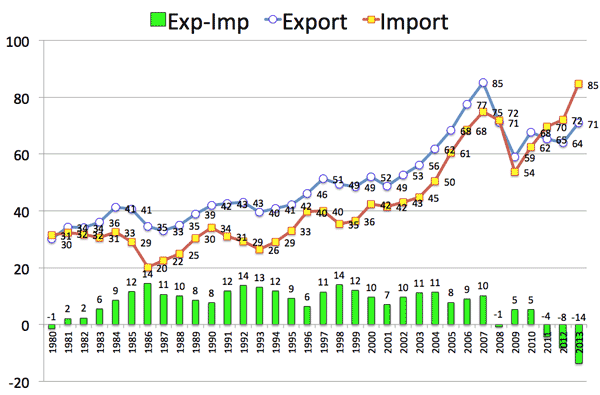 - Balance of Payment of Japan (1996-2013): (MOF) Unit: Yen T
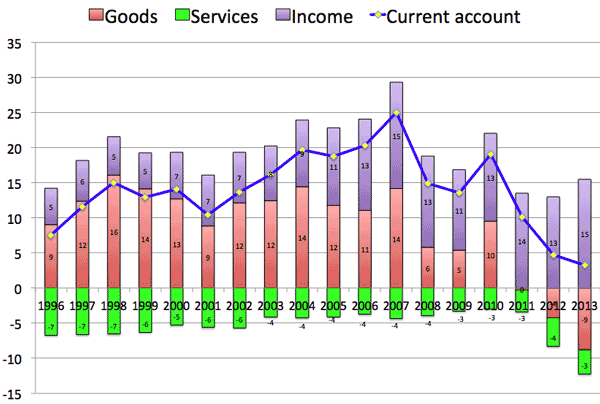
- Current account balance surplus matter for Japan to recover
- >Top Overseas Production Ratio and Overseas Sales Ratio: (METI)
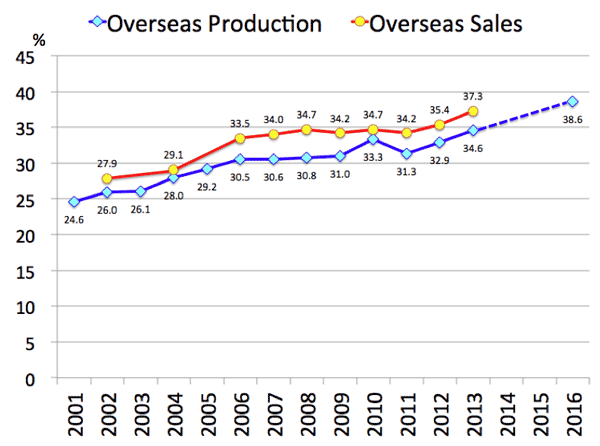 - Overseas Production Ratio by Industry: (METI)
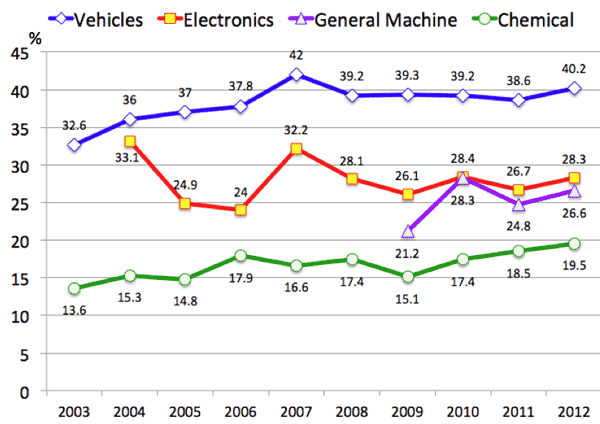 |
1. 貿易黒字の重要性:
- 輸出入統計
- 貿易黒字:
- 7兆/2001
- 10兆/2007
- -14兆/2013
- 世界景気に連動か?
- 輸出額
- 経常収支黒字:
- 250兆円(1996-2013)
- 138兆円(2001-2008)
- 輸送機械
- エレクトロニクス
- 製造業
- 化学
|
>Top 2. Change of trade structure:
- Impact of overseas production on trade balance:
- Export inducement effect: may affect to increase export
- Import diverting effect: may affect to divert import
- Export substitution effect: may affect to decrease export
- Reimport effect: may affect to reimport
- Export ratio was peak in 2007; from 2008 it declines particularly in the export of vehicles, chemicals, and textile.
- Overseas affiliated companies also decrease import ratio from Japan.
- Reimport from overseas electronics to Japan increases from 2004, which shows how domestic electronic factories are shrinking.
- However reimport for overseas vehicles to Japan does not increase so much, which shows domestic vehicles production is still strong.
- Export structural change; after Lehman Shock
- Export competitiveness of vehicles and electronics (which were leading force as the competitive export items from Japan)
- Particularly electronics industry are losing competitiveness in domestic production bases; showing rapid increase in import penetration ratio (import/production) and reimport ratio.
- concentration in more knowledge-intensive areas, which changing import of existing areas.
- Regarding vehicles industry, import penetration and reimport are not remarkable, though exporting ratio has saturated; thus domestic production bases looks firm and strong.
- but the main markets are shifting to emerging countries, where domestic vehicles are getting difficult to export.
- Oversea production need to expand, while domestic production should focus more strategic target.
- Regarding general machines industry, the export ratio is increasing, showing to lower import penetration ratio; thus domestic production bases are getting stronger.
- There is active demand in emerging countries in investment in social infrastructure and food production; thus export of construction, mining, and agriculture machines are promising. In addition, high-tech parts and high-functional materials retain competitiveness in export.
|
2. 貿易構造の変化:
- 海外生産の貿易収支への影響
- 輸出誘発効果
- 輸入転換効果
- 輸出代替効果
- 逆輸入効果
- I期:1985-95
- II期:1996-04
輸出誘発効果
- III期: 2005-11
輸出代替効果
|
>Top 3. Return current overseas profit:
- Japanese overseas investment is showing export substitution effect or reimport effect, causing graduallly trade balance deficit.
- 2011 was such turning point of year; Japanese trade balance became deficit, which means overseas investment entered into stable opeation.
- Such phenominon does not mean simple hollowing our domestic industry, or deindustrialization. It can contribute to bring Japan extra profict on current accout balance, though may causes trade balance deficit.
- Also, receipt by direct investment together with royalities and licenses fee is increasing sine 2000.
- Vehicles industry are shifting from export-centric domestic production model to overseas product and profit return model.
- Electronics industry has not yet succeeded in profitable overses opeation.
- Direct Investment profit and Royalty & Lincense fees receipt:
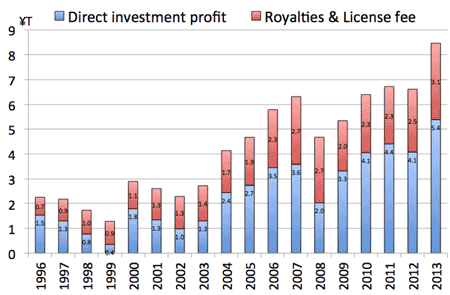 |
3. 海外収益の還流:
|
>Top 4. Implication from US overseas operation:
- US shows large current account deficit is due to enormous trade deficit, while enjoys large amount of profit of direct investment and royalty and license fees; in particular such figures are accelerating since 2000.
- Profit ratio of overseas operations show more than three times bigger than that of Japan.
- Reasons of US profitability of overseas companies:
- Autonomous management of local companies.
- Active R&D, developing appropriate products & services for the local market.
- Localization of management, pursuing synergy effect of other affiliated companies.
- Global rotation of eligible staff, and continuous global HRD
- Japan should promote two-front war operation:
- Domestic production: capital goods and high-tech parts and materials
- Overseas production: durable consumer goods such as vehicles and electronics
- Overseas production also can contribute to same domestic energy consumption together with developing more saving energy products.
- Maintaining current account surplus is possible though the trend of trade deficit continues.
|
4. 米国海外事業からの示唆:
- 米国は巨大な貿易赤字→経常収支赤字
- 一方で、巨大な直接投資収益と特許権利用料
- 現地法人の経営の特徴
- 経営自主性
- R&D
- 経営の現地化
- グローバル人材異動と育成
- 日本は二面作成
- 資本財や高度部品素材は国内生産
- 耐久消費財は海外生産
|
>Top 5. Cf: Theory of Current Account Development: (METI)
- Current Account Development Stage (METI)
-
| |
Immature
Debtor Nation |
Mature
Debtor Nation |
Repaying
Debtor Nation |
Immature
Creditor
Nation |
Mature
Creditor
Nation |
Credit
Disposition
Nation |
| Current A/C |
- |
- |
+ |
++ |
+ |
0 |
| Trade & Service |
- |
+ |
++ |
+ |
- |
- |
| Income |
- |
- |
- |
+ |
++ |
+ |
| Ext. asset |
- |
- |
- |
+ |
++ |
+ |
| Capital |
+ |
+ |
- |
-- |
- |
+ |
- Import of goods is equal to the import of labor who are inputted to make the goods. (Factor content of trade)
- IS (Investment Saving) Balance: (Cf: 21C vision, Cabinet Office)
-
| |
2005 |
2030 |
| |
|
Curb expenses |
Maintain expenses;
Increase tax |
| Current account balance |
4 |
2 minus |
1 minus |
| |
Goods & Service |
2 |
-2 |
-3 |
| |
Household |
4 |
2 minus |
1 |
| |
Government |
-7 |
-1 |
-1.5 |
| |
|
National/Local G |
-6 |
-3 minus |
-3 plus |
| |
|
Social security fund |
-1 minus |
1.5 |
2 minus |
| HH Savings |
6 plus |
3 |
2 |
-
- Current Account Income Balance Model: GDP % (METI)
-
| |
2005 |
2030 |
| Current account balance |
3.6 |
2.9 |
| Trade & Services |
1.4 |
-1.6 |
| |
Export |
14.3 |
23.5 |
| |
Import |
12.9 |
25.1 |
| Income balance |
2.3 |
4.5 |
| |
Receipt |
3.1 |
6.7 |
| |
Payment |
0.8 |
2.3 |
- Current account balance will decrease surplus, due to saving ratio decreases by aging society.
- Aging society will increase import bigger than the growth of export.
- Income balance will increase nearly double, by increase both ways of receipt and payment. (multilinear track)
- Statistics of Japanese population: (MOF): Unit Yen T
- Japanese competitiveness of export is constantly growing since the period of the lost decade (1990-2000) until 2007.
- The drop of export (2008-2009) was due to Lehman Shock, but after the export recovered.
- The amount of export and import matters; not the productivity.
- Around Y3T in 1990s, but jumped Y15T i 2007.
- Japan is not only exporting goods country, but a good money lender or investor.
- The other hand, Japanese government owes enormous public debt (Y1400T), but most of such debt is owned by Japanese financial institutions and individuals.
They receive the interest from Japanese government (Y5T annually)
- Overseas investment to Japan is inactive due to too low rate of interest.
- The balance of current account was peak in 2007, amounting Y25T. (around Y6T in the bubble period)
- The profit of current account (1996-2013) earned from overseas amounts Y250T.
|
5. Cf: 経常収支発展段階説 (METI)
- 未成熟な債務国
- 成熟した債務国
- 債務返済国
- 未成熟な債権国
- 成熟した債権国
- 債権取崩国
- 日本は現状は未成熟な政権国の段階
- 今後はコスト高から自国製品の国際競争力減退し、貿易サービス黒字減少
- 過去の経常黒字による海外資産の増加から所得収支は増加
- 資本収支は経常収支の減少により赤字幅減少
- 第5段階の成熟した債権国へ
- 但し、少子高齢化による貯蓄率低下からISバランスが変化し、経常収支黒字幅減少/赤字化傾向
(21世紀ビジョン)
- 財の輸入は財の生産に投入された労働力の輸入と同じ
(Factor Content of Trade)
|




